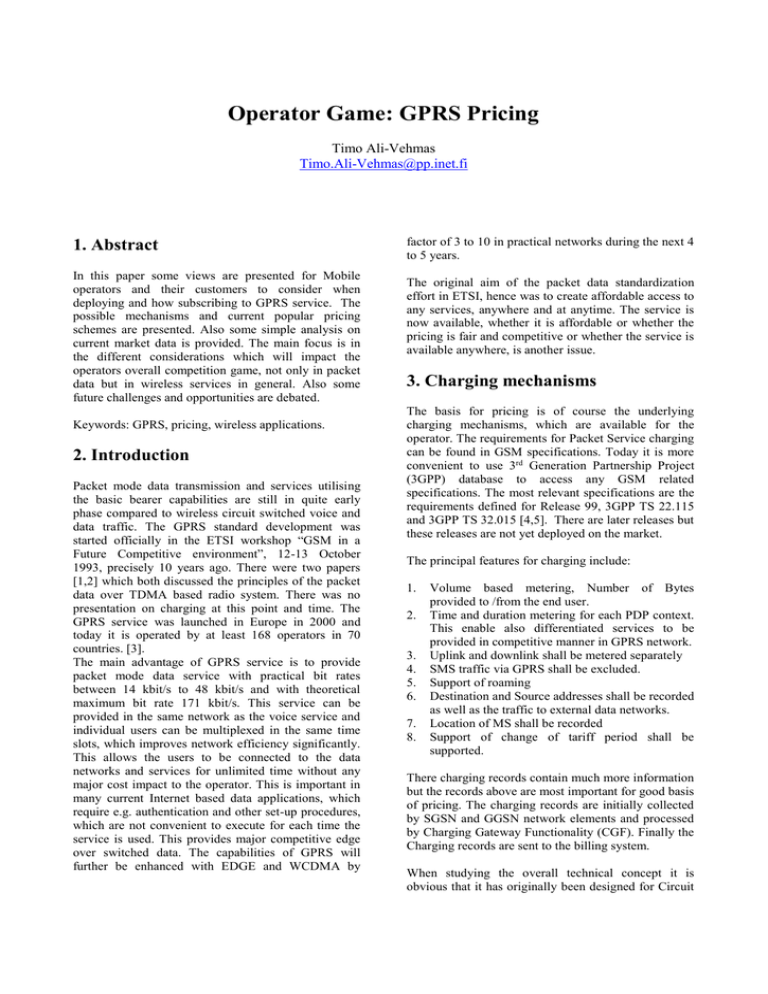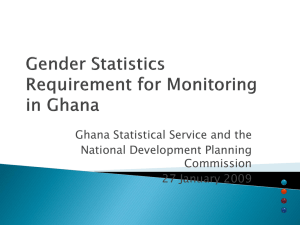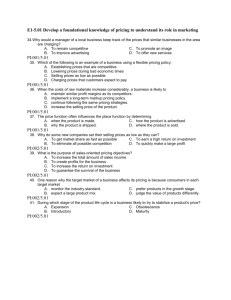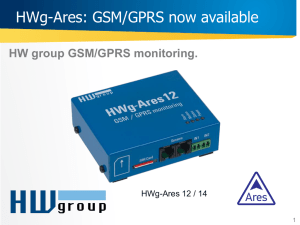Operator Game: GPRS Pricing 1. Abstract Timo Ali-Vehmas
advertisement

Operator Game: GPRS Pricing Timo Ali-Vehmas Timo.Ali-Vehmas@pp.inet.fi 1. Abstract In this paper some views are presented for Mobile operators and their customers to consider when deploying and how subscribing to GPRS service. The possible mechanisms and current popular pricing schemes are presented. Also some simple analysis on current market data is provided. The main focus is in the different considerations which will impact the operators overall competition game, not only in packet data but in wireless services in general. Also some future challenges and opportunities are debated. Keywords: GPRS, pricing, wireless applications. 2. Introduction Packet mode data transmission and services utilising the basic bearer capabilities are still in quite early phase compared to wireless circuit switched voice and data traffic. The GPRS standard development was started officially in the ETSI workshop “GSM in a Future Competitive environment”, 12-13 October 1993, precisely 10 years ago. There were two papers [1,2] which both discussed the principles of the packet data over TDMA based radio system. There was no presentation on charging at this point and time. The GPRS service was launched in Europe in 2000 and today it is operated by at least 168 operators in 70 countries. [3]. The main advantage of GPRS service is to provide packet mode data service with practical bit rates between 14 kbit/s to 48 kbit/s and with theoretical maximum bit rate 171 kbit/s. This service can be provided in the same network as the voice service and individual users can be multiplexed in the same time slots, which improves network efficiency significantly. This allows the users to be connected to the data networks and services for unlimited time without any major cost impact to the operator. This is important in many current Internet based data applications, which require e.g. authentication and other set-up procedures, which are not convenient to execute for each time the service is used. This provides major competitive edge over switched data. The capabilities of GPRS will further be enhanced with EDGE and WCDMA by factor of 3 to 10 in practical networks during the next 4 to 5 years. The original aim of the packet data standardization effort in ETSI, hence was to create affordable access to any services, anywhere and at anytime. The service is now available, whether it is affordable or whether the pricing is fair and competitive or whether the service is available anywhere, is another issue. 3. Charging mechanisms The basis for pricing is of course the underlying charging mechanisms, which are available for the operator. The requirements for Packet Service charging can be found in GSM specifications. Today it is more convenient to use 3rd Generation Partnership Project (3GPP) database to access any GSM related specifications. The most relevant specifications are the requirements defined for Release 99, 3GPP TS 22.115 and 3GPP TS 32.015 [4,5]. There are later releases but these releases are not yet deployed on the market. The principal features for charging include: 1. 2. 3. 4. 5. 6. 7. 8. Volume based metering, Number of Bytes provided to /from the end user. Time and duration metering for each PDP context. This enable also differentiated services to be provided in competitive manner in GPRS network. Uplink and downlink shall be metered separately SMS traffic via GPRS shall be excluded. Support of roaming Destination and Source addresses shall be recorded as well as the traffic to external data networks. Location of MS shall be recorded Support of change of tariff period shall be supported. There charging records contain much more information but the records above are most important for good basis of pricing. The charging records are initially collected by SGSN and GGSN network elements and processed by Charging Gateway Functionality (CGF). Finally the Charging records are sent to the billing system. When studying the overall technical concept it is obvious that it has originally been designed for Circuit switched network. There are several new challenges in the packet network, especially when such a high number of different data shall be collected and processed. One of the main challenges is the real time requirement, which enable the real time charging. Real time charging is very important factor in pre-paid markets. sent to the subscriber. Pricing in principle is more a business decision process, how the tariffs are set. In the literature these terms are used to address both processes. In this paper term “pricing” means fundamentally the latter. 4.1 Summary of current schemes Data Network (Internet) The following mobile and service providers were studied: TeliaSonera Finland Radiolinja DNA Saunalahti Inter-PLMN Network Gp Gi PS Domain GGSN G-CDR CDR Ga Gn CDR CGF SCF Ga CAP IuPS Gb RNS BSS BSC RNC BTS Node B Um When looking at the current schemes there are some main findings. Most of the schemes are available only as an add-on service to basic voice service. There are some schemes, which can be ordered as stand alone data only subscriptions but it makes more sense at this point to compare combined voice with data price plans. Node B Uu MS Picture 1. Reference GPRS charging system in standards. The major challenge in complex charging like in GPRS, is to keep the charging costs significantly below the possible revenue the service itself generates. 4. Current GPRS pricing schemes The GPRS charging schemes have been studied widely in several papers and presentations [6, 7, 8]. These schemes do propose to utilise the mechanisms mentioned above in many different ways. At least following schemes have been proposed: 1. 2. 3. 4. 5. 6. 7. And for comparison point, the world’s largest mobile operator, Vodafone, was selected. CDR M-CDR S-CDR S-SMO-CDR S-SMT-CDR SGSN BTS Billing System Volume metered charging Block Charging Fixed (flat) Charging Edge Pricing Expected Capacity Charging Paris Metro Charging Market based reservation Charging However, today only very basic charging schemes are utilised. When going through the operators offering only the first two schemes were found. Not all the pricing schemes for all operators were available. It may be useful to clarify here: Charging in principle refers to the overall process how charging records are collected and processed and how the adequate bill is All of the schemes have some kind of monthly fee, ranging typically from 3.5 to 20 € but reaching up to 188 € for 100 MB block pricing plan of Vodafone. Where volume based pricing was used, the range was from 1.2 to 11 € per MB. In all schemes it was assumed that uplink and downlinks were calculated separately according to the spirit of GSM specifications. For peer to peer traffic the remote end is charged separately for data traffic, which needs to be taken properly into account. The variation of the schemes is very high but there is one interesting phenomenon. All of the schemes (except the DNA) were exceeding by factor of 4 or 2 the price of CS voice call. (Factor 2 in case of client to server connection and factor of 4 in case of peer-topeer data connection, between two mobiles.) In CS voice call only call time for A subscriber is taken into account. It is assumed that in voice traffic competition the price level has already achieved the current equilibrium point. Price level of CS voice call was calculated at the rate of 13 kbit/s assuming 8 bits per Byte and sampling the tariff schemes randomly. There are some pricing schemes offering block pricing also for voice, which is a bit difficult to compare. Hence only the given metered prices were used. Value of 1,64 €/MB was used. Also one CS data tariff is given as reference, showing that there is some difference between the data and voice traffic pricing. Part of that is definitely due to the different C/I requirements for voice and data. For instance at reference sensitivity level as defined in GSM specifications, the BER for one scenario 14.4 kbit/s data traffic is 2% while in the same scenario to RBER for EFS voice traffic is only 0.11 %. Competition in circuit switched data may not yet be very harsh and therefore the equilibrium price level is not known. Value of 2.03 €/MB was used. Therefore it is not so obvious, whether the cost structure of CS voice or CD data traffic is the best comparison point for GPRS traffic. Maybe these could be used as upper and lower limits. But still there is one specific observation to be made. The DNA’s GPRS pricing scheme beyond any speculation below the CS pricing at the monthly usage level of just below 100 MB and beyond. Practical Service Pricing 250 VF Pp VF AT30 200 VF B Monthly Cost, Euro VF B 100 TS PB 150 TS PO TS PP 100 really starts or operators are going to gain a lot of profits for simply the basic bit pipe traffic of GPRS. 4.2 Applications and needed bandwidth It may be useful to compare some of the applications and their expected use of bandwidth. This is quite difficult comparison and should by no means be taken as the only interpretation. But anyway it probably gives some kind of a feeling on the magnitude. In the following table some estimates are given. MMS is assumed to be either normal 30 kB or rich 100 kB MMS and the usage being low or high, i.e. 1 or 10 MMS’s per day. For MMS it should be noted that for the operator, only the A subscriber will pay. The B subscriber gets the service for free. Email usage is either a text email or text with some low quality image, and the usage being about 10 emails per day. Browsing is very problematic to estimate since for different people this means quite different things. A 2 MB per day for one end-user means downloading only few normal WEB pages but several tens of WAP pages, which typically are only less than 30 kB. Sa PD RL PD 50 DNA PD CS Voice CD Data 0 0 1 2 4 8 16 32 64 128 Basic Voice and additional GPRS Data, MBytes Picture 2. Practical service pricing vs. transmitted bits Anyway, the original main goal of the GPRS was to provide fair and reasonable best effort data access to any data network is still quite far from reality. Even with DNA pricing scheme no advantage of best effort behaviour of packet data is available to the customer. The premium CS service always reserve the whole TDMA slot but GPRS only when there is something to transmit and there is currently no real time delay requirement for GPRS traffic either, hence the operator could operate GPRS at almost marginal cost of the network. It should be noted, however, that using DTX in voice traffic (and in CS data traffic) will help the operator to gain spectrum savings for voice, too. It should also be noted that the cost of the GPRS infra is only marginal when compared to the overall infrastructure cost of a GSM system. This means that low additional or marginal price premium is proposed for GPRS traffic over CS traffic and it may well be that the best effort and multiplexing capabilities should compensate this Capital expenditure and therefore the GPRS price level should be clearly below the reference price level of CS traffic. Therefore, there seems to be a lot price reductions expected when the competition in packet services For some future needs we may also consider new packet based services such as Push over Cellular (or Push to talk) and also delivering some rich content such as MP3 encoded music. Low POC usage is only one one-minute POC activity (session) per day, medium is already 10 roughly one minute conversations and heavy would mean 60 minute POC conference each day. It is assumed 100% overhead for POC because of low delay, poor payload because of short frames and lots of header bits as wells as some error protection. The B subscriber costs are included too, since in POC case these costs are real. MP3 delivery assumes typical 3 minute piece of music which materialises as 3MB file using MP3. The details of the new services are discussed in more details in Chapter 5 MMS low MMS high MMS high, rich content Email text Email low Email practical Browsing practical Push over Cellular low Push over Cellular medium Push over Cellular heavy MPEG delivery 0,9 9 30 0,3 6 30 60 6 60 360 90 Table 1. Some cumulative monthly requirements of bandwidth in Megabytes per various applications usage patterns. Based on this comparison it is obvious that text email is a tough challenger for text SMS since one email would cost only less than 1 €sent with GPRS compared to 12 or more €sent as a current range of tariffs. Also 300 regular MMSs would create only 9 MB, worth of 14 € traffic vs. 300*0.35, about 100 € revenue using current “competitive” MMS tariffs. based on the practical knowledge of revenue sharing between operators and service providers. 4.3 Observations of the current market There is a significant danger that SMS and MMS traffic will be challenged by email based GPRS traffic. Naturally, the convenience of SMS and MMS which provide automatic downloading, good interoperability and especially for SMS, very good roaming will delay this competition. With current prices practical browsing is not going to be mass-market service but on the other hand there are a lot of WEB addicts who probably will pay happily if they can access their favourite pages through GPRS. To access some selected pages, without all the images and other high resolution content definitely makes browsing also quite possible. Also for corporations the improved efficiency of the business processes may motivate utilising browsing in many applications. There are also solutions available which provide proxy or content adaptation services for corporate internal use of intranet WEB pages or email over wireless. These services may be used in early phase to make browsing and also corporate email more suitable for current GPRS value systems. It should be noted that some operators, Vodafone, bundles the GPRS pricing and the used URL’s. As long as the end user is browsing Vodafone’s own WEB pages the price is only less than 2% of the regular price. Obviously service bundles will play a role in GPRS pricing and as shown in chapter 2, this is also widely possible based on the GSM standards. Value of transmitted MB (all radio channels included) 10000 1000 100 €/MB 10 The GPRS market and competition is still in very early phase. The mobile operators have oligopoly in Finnish market, mainly because of the limited number of spectrum licenses. Finnish regulation is quite liberal and there are no regulative stumbling blocks, which hinder service providers to emerge. The current service operators, however, are re-tailing GPRS data using one network operator only. Therefore only moderate competition is possible. Corporate communication needs have been often the driving force to shape the markets after initial launch. Consumers will find the services only after corporations have made it first broadly available and affordable. It is expected that similar behaviour will be seen in case of data communication in mobile environment. It is important that corporations invest in mobile applications and also force the competition in GPRS to reduce the price level to moderate. This further on pushes the operators to invest moderately more to support the growing traffic. It is also important that the characteristics of the new traffic is according to the initial design rules for GPRS, otherwise the cost structure will not allow the price level to drop. GPRS was initially developed to support email, file transfer and moderate browsing. The key step further would be ISPs to be able to copy the behaviour of the corporations, i.e. to make service agreements with several network operators. The bargaining power of significant ISP may be high enough to push the price levels down. This is already visible in case of Saunalahti, who are able to offer lower price level that their network operator, TeliaSonera. Should they make another agreement with for instance DNA, it would most likely impact the competition positively, from consumers’ perspective. This however might need new usage of current SIM/USIM (subscriber Identity Module for GSM and for UMTS) standards. Along with Release 5 of 3GPP, the IMS (Internet Multimedia Subsystem) and the ISIM (IMS SIM) may one day enable this in practise too. 1 0,1 RING TONE SMS MMS BitPipe CS Call MPEG download Picture 3. Value of transmitted Megabyte This is demonstrated by the graph above, which shows the value of each MB transmitted over one radio path (uplink or downlink, A subscriber only) using the rule of thump prices of reviewed operators. Some reasonable service price is also taken into account The point is today that operators are protecting their current cash cows, SMS and Circuit switched voice service but at the same time they are watching each other to see, if the number of subscribers starts growing rapidly in their competitors’ network, they have to be ready to respond fast, in a matter of days, not months and not definitely in years. The paradigm shift may happen quickly as we seen in Finnish market where number portability was introduced mid 2003. In order to make this happen in GPRS or in data traffic in general, it naturally will require that relevant application are portable as well. 5. Future challenges There are some new services, which will be introduced once the competition pushes the GPRS prices down. These new services may introduce some totally new challenges to operators when they develop their pricing schemes. 5.1 Case MP3 delivery There is an obvious need to deliver music such as MP3 music files the same way as we have ring tone or wall paper business today. The value of ring tone business worldwide is quite significant and no operator can afford not to participate the value system. The main difference, however between ring tones and MP3 music is the difference in the file size. Ring tone can be packed into one SMS and hence requires only minimum bandwitdh while MP3 music requires some 1 MB per one minute of music. With the current pricing schemes this is impossible equation to service providers who might want to receive similar revenue as with CD business, ie. 20 € for 10 pieces of music. Even if we assume some 25 % premium for over the air delivery, the air time revenue can be only marginal to current bit pipe prices and even lower than current one radio link revenue of CS call. This will make the operators to consider also “worse than best effort” GPRS pricing. This can be implemented by combining the information on the congestion in the network and the service delivery time and sending the file over when there is no other normal traffic at the same time in the same cell. There are some special issues related to this type of delivery. It assumes that PDP context is not lost even if the radio connection is lost for a moment because of hand over or other radio anomaly. The connection shall support so called progressive downloading. And what is most important for operators, they shall not show the respective bit pipe revenue but the pricing scheme shall only show the end user parameters, such as 1 song, delivery in 1 hour at the price of 2.5 €. 5.2 Case Push over Cellular Therefore there is at the same time a need to take the QoS in use in GPRS networks at least up to streaming class and at the same time introduce maybe another pricing scheme, time based pricing to packet networks. 5.3 Observations of the future possibilities Competition will impact the prices in GPRS without any doubts. The basic market forces are working and enable the corporations and service providers to negotiate better and better wholesale price levels. There are also other means to impact the GPRS pricing, which is the use of alternate radio accesses. WLAN is growing now fast in corporate segment and corporations are looking integrating their overall communication systems on the top of the IT infrastructure. One evidence of this is a VoIP service which is available using Cisco System Intranet technologies and WLAN based voice terminals, together with standard laptop PC’s which will provide the netmeeting or other conferencing capabilities. This is quite useful solution for corporations in their internal communications even in global perspective. By combining this with either WLAN roaming or more likely cellular roaming with similar data capabilities will help the corporations to reduce their operating costs of the networks and at the same time provide very efficient tool to increase internal efficiency. New applications such as Push over Cellular or MP3 delivery provide operators new tools to segment the GPRS offering and provide additionally to the basic Best Effort traffic also premium services such as POC with better pricing than average and on the other hand bundled services like MP3 delivery with maybe “worst effort” type QoS. Email may actually work quite well using the same paradigm of “WC” traffic and hence protect the SMS and MMS as premium messaging services. 6. Conclusions Another interesting new service is Push-over-Cellular, which introduces “walkie-talkie” service to cellular network, with the added functionality of global operation from day one (if GPRS roaming is supported). In this paper some pricing schemes of the current network and service operators are discussed based on the mechanisms, which either exist or will exist in the GPRS networks in near future. Also requirements of various applications are briefly introduced and compared to the capabilities as well as to current pricing schemes. This service can be implemented on the current GPRS networks as they are but the cost structure with current GPRS prices is problematic, with volume based pricing the service is typically too expensive and with flat rate pricing it may compete too effectively with some premium services such as CS voice conference. GPRS is still in its early phase even if it is already available in quite a many network. There are still shortterm challenges with roaming and pre-paid, which must be solved before GPRS is really widely used. GPRS pricing is currently very high when compared to pricing of bulk CS voice traffic, which indicate only limited competition so far in GPRS. Major pricing competition moves are therefore expected in the forthcoming months and years. Large corporations are essential in driving the competition and setting the rules for ISP and other service providers to follow. [7] Cushnie John, Hutchison David, Oliver Huw, Evol ution of Charging and Billing Models for GSM and Future Mobile Internet Services. 14th July, 2000. http://www.hpl.hp.com/techreports/2000/HPLIRI-2000-4.pdf [8] Cushnie John, Hutchison David, Charging and Billing models for GSM and Future Mobile Internet Services. http://www.comp.lancs.ac.uk/computing/users/c ushniej/papers/pg_charging:models.pdf [9] Vodafone’s price list, November 2003. http://www.vodafone.co.uk/cgibin/COUK/arrival.jsp?arrivalContext=access (Note, Vodafone does not allow direct connection to the actual page. Access via main page only) The winning formula however is that who can provide the lowest cost for highest penetration earliest, will be the final winner in the market. [10] Sonera’s wireless communications services for business, Price-list, 18 May 2003, http://www.sonera.com/GetImages/GetImages_ GetImage_pdf/0,1440,37368,00.pdf References [11] Radiolinjan hinnasto kotimaassa 2003. https://www.radiolinja.fi/go?sessionid=hDb5W m9TvP&section=asiakaspalvelu/hinnasto&page =puhelu_ja_kayttomaksut_h&lang=fi&type=1# data2 [12] DNAn hinnat perusliittymä 1.7.2003 http://www.dnafinland.fi/yksityisille/liittymat_ja _palvelut/gsm/hinnat_dna_perusliittyma.shtml [13] Saunalahden GSM liittymät http://saunalahti.fi/gsm/gsm.php New emerging applications may introduce also totally new pricing schemes for GPRS when services such as MP3 delivery and Push-Over-Cellular are used widely in the networks. Segmentation of the GPRS traffic based on QoS is essential tool for operators to be able to provide services for various types of customers and to support their need. New radio technologies may have some limited impact in selected environments and markets but without full roaming capabilities they cannot impact the overall market. Multimedia and multiple access technology solutions are likely to support the growing data communication without changing the basic rules dramatically. [1] Hämäläinen Jari, Rautiola Markku, Soikkeli Jukka, Rajala Jussi, Jokiaho Timo: Packet Data over GSM Network. ETSI SMG workshop, 12-13 October 1993. [2] Decker P, Walke B. : A General Packet Radio Service proposed for GSM. . ETSI SMG workshop, 12-13 October 1993. [3] GSM Association home http://www.gsmworld.com page at [4] 3rd Generation Partnership Project; Technical Specification, Group Services and System aspects, Service aspects; Charging and billing (Release99), 3GPP TS 22.115, version 3.0.0, 2003-03, http://www.3gpp.org/ftp/Specs/htmlinfo/22115.htm [5] 3rd Generation Partnership Project, Technical Specification Group Services and System Aspects; Telecommunication Management; Charging management; Call and event data for the Packet Switched (PS) domain (Release 1999), 3GPP TS 32.015, version 3.11.0, 200303, http://www.3gpp.org/ftp/Specs/htmlinfo/32015.htm. [6] Ahonen Annukka, GPRS Charging Schemes, 2003. http://keskus.hut.fi/opetus/s38042/k03/topics/GP RSChargingSchemes.pdf 1.12.2002





